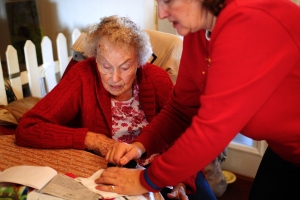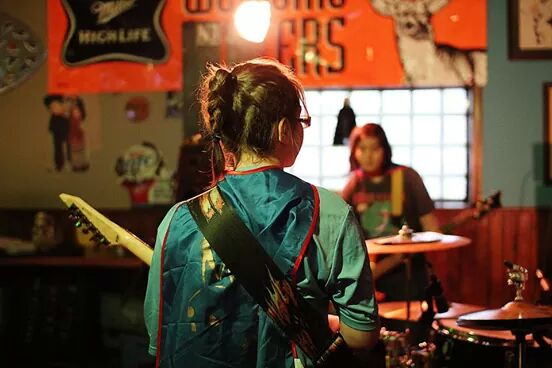Digital Artwork Samples
Custom movie-poster design based on the following request: “Two friends sitting by a fire, holiday sweater themed design.” Created in Photoshop.
Custom request for a t-shirt design based on an image of the band members. Created in Microsoft Paint and expanded to enhance the “8-bit” style for a more retro feel.

T-shirt design based on the concept of “an alien abduction.” Hand-drawn and lettered, then converted to digital using Adobe Illustrator.

Album cover design based on the parable of the two wolves and the album title “The One You Feed.” Hand-drawn and scanned, enhanced using Adobe Illustrator to add text.





JRN521 Final Project: Beyond the Binary

Transgender: It’s a term most of us are familiar with by now. So why are we talking about this? Caitlyn Jenner is as famous as any cis-gender celebrity, if not more so for her notoriety, so doesn’t that mean that we have already climbed this mountain?
Not exactly.
Token individuals’ success, though it does provide a much-lacking source of media representation, is often a far cry from the average trans individual’s life. The celebrities who are so often offered as examples of how “anyone can make it,” (Ellen Degeneres, Caitlin Jenner) in actuality, would never have the level of visibility and acceptance they have now, had they not already achieved a massive level of fame along with a well-established fan base before “coming out” to the media. And even then, look at the hate that these individuals must face, simply for being a voice for a group that, previously, had none.
The numbers speak for themselves. When we compare statistics of transgender people to cis-gender individuals, it becomes increasingly clear that there is an ongoing trend which is only being supported by the system in place. For example: despite being, on average, more educated than cis individuals, trans people have a lower household income, namely because they simply do not get the same consideration for jobs which they may be equally qualified for. Likewise, trans individuals are 8 times more likely than cis individuals (in every age group) to be below the poverty line.
When we start to talk about the percentage of the trans community that has struggled with mental health or attempted suicide, the conversation gets even more somber.

What a lot of us fail to realize is that it is a much broader term than we think. When we talk about trans people, we are usually referring to either trans men or trans women. However, there are individuals who exist under the umbrella of transgender who do not wish to transition to the “opposite” gender, rather they identify somewhere in between, or even completely separate from those categories.
The problem is, it is all but impossible to find accurate information as far as the numbers of non binary individuals that exist, due to visibility issues, and, due to the standard binary options on most official forms and documents, lack of a venue to express their “other” category. And when we extend that and look beyond the male and female categories, with the little data we have, we can draw the conclusion that non binary individuals are at a distinct disadvantage. While having to experience the discrimination against even trans individuals within the binary, non binary individuals also face the difficulties associated with not fitting into the existing social categories.
As recently as 1994, nearly 70% of professionals interviewed believed their peers in the medical field had given substandard treatment to a patient due to their patient’s sexual orientation. Even medical professionals who have moved beyond this line of thinking and are happy to treat patients of any orientation can struggle with the idea of non binary. The concept of existing outside of a category, especially one as deeply ingrained as the “male” vs “female” binary, can seem incompatible with the approach many medical professionals take. When seeking access to transition-related care, it is unfortunately still quite frequent that non binary individuals must present in an exaggeratedly masculine or feminine manner, as doctors are more likely to acknowledge, and thus, treat, the existence of dysphoria in binary (male to female or female to male) trans people.
Likewise, non binary individuals face problems when it comes to employment, as standard applications feature only “male” and “female” categories to choose from, and are often not considered if left blank. The same is true for housing opportunities. If awareness alone was the solution to the problem, the battle would be not so daunting. Unfortunately, even in cultures where a third gender has been officially recognized, assault and prejudice against individuals in that group remain. Awareness and recognition is only the beginning.
But inaction is not the answer in the face of a daunting task. If one does not make an effort to act in a conscious way, they simply follow the path of least resistance. Unfortunately, we have seen where the easy path leads. Instead of choosing to believe that in time, culture will shift on its own, we can make a decision to be that change.
So what steps can we make towards a more all-gender inclusive society?
1.Use your pronouns.
Openly introduce yourself using the pronouns which you use to identify with, and if you are in a position of power within a group, request that others do the same. Instead of assuming that everyone presents themselves in a way that directly corresponds with the gender identity that they hold, approach gender on a more individual level.
And remember: If you make a mistake, it is important to say sorry, but it is MORE important to make sure you learn the RIGHT way so that you don’t make that same mistake again.


Check out Beyond the Binary on Instagram
join in the conversation using #BTBCMU
2. Ask questions when you have the chance, listen to and learn from those who have experience.
Deanna Heath: Gender Therapist
Deanna Heath (she/her/hers) is an owner and therapist at Mount Pleasant Counseling, who has been working with trans and nonbinary individuals for years. Listen to her story and learn some of the insight she has gained through her work.
Kai’s Story
Kai Neizgoda (they/them/theirs) is a student activist and intern with the Office of LGBTQ Services at CMU. Check out their story.
3. Understand that trans and nonbinary people just want to have the right to exist.
Jak’s Story
” I will become what I deserve”
Jakson Grubbs (they/them/theirs)
Jak Grubbs is a 21 year old senior preparing to graduate from Central Michigan University with a degree in Psychology and Communicative Disorders. They began identifying as non binary, trans-masculine, about a year ago, and has recently passed their 3 month milestone of being on Testosterone. Grubbs is also extremely involved both on and off campus, as part of To Write Love on Her Arms, a group that focuses on mental health and suicide awareness, Spectrum, a group for trans and non binary individuals, as well as other off-campus activism and volunteer commitments, Jak’s time is usually divided between school, volunteering, work, and their relationship.
Luckily, Birdy Wurtz, 20, is also very involved, and, when not working, spends as much time as possible supporting Jak in their involvements. On April 28, 2016, Jak proposed to their partner Birdy Wurtz, 20, at the Dreamer Coffee Shop on CMU’s campus, where they first met. “My story was so sad before you,” writes Grubb in their proposal video. Having a support system is a huge part of life, and with family not always supporting Jak’s lifestyle choices, Birdy and Jak quickly found home together. After graduation, the two have signed a lease together and will move into their first apartment, where they will spend the summer before Jak begins grad school working. Jak received their acceptance letter to attend grad school at CMU on this date.
The Next Chapter: Jak and Birdy
“Crayola Changed My Life”
JRN521: Portfolio, Resume
Here is a link to my online portfolio.
My resume and cover letter can also be found on my website-but here is a direct link.
Thanks for looking!
JRN521: Your Choice 3 (Photo Story)

LaValley grins towards a teammate as they wait for the match to begin.

Scott LaValley, of Lake Orion, began playing dodgeball at Saginaw Valley State University. When he transferred and began his time here at Central Michigan University, two years ago, he still saw many of the same faces, but this time, they were on the other side of the court.
LeValley is a senior majoring in Biology and Natural Resources, which requires a lot of time commitment to homework and lab work. After rooming with the former president of the team last year, LaValley ended up taking over the position, so. in addition to his class schedule, LaValley is the Team President of the CMU club dodgeball team.
The team practices tree times every week, Mondays from 9-11, Tuesdays from 8-10pm, and Thursdays from 7-9. Usually practice begins with drills, to get everyone warmed up and working together as a team before the action really begins.
“We have our small groups that are good friends, and some of us have played together previous years,” so the dynamic of the team is always evolving, says LaValley. Even with such a large group of people, the team still manages to stay tight-knit. “Everyone gets along when we are on the court… we are family out there.”
His favorite part of the game? “Outside of just having fun… hitting somebody in the face.” LaValley laughs. “When you get them really good, you get to watch that ball arc up, and then CRACK when it hits them. You get such a rush, and like everybody cheers.”
“It really pumps up your team a lot,” LaValley continued- which is what it all seems to be about: playing as a team, getting to know each other’s strengths and weaknesses, and working on them together.

LaValley takes a break during practice to tape his fingers. Taping gives players the advantage of a better grip on the ball during play, but if done improperly, or using the wrong tape, can also result in toughening of the skin and difficulty in bending fingers.

LaValley releases one of the two balls in his possession towards an opposing team member during a practice match.
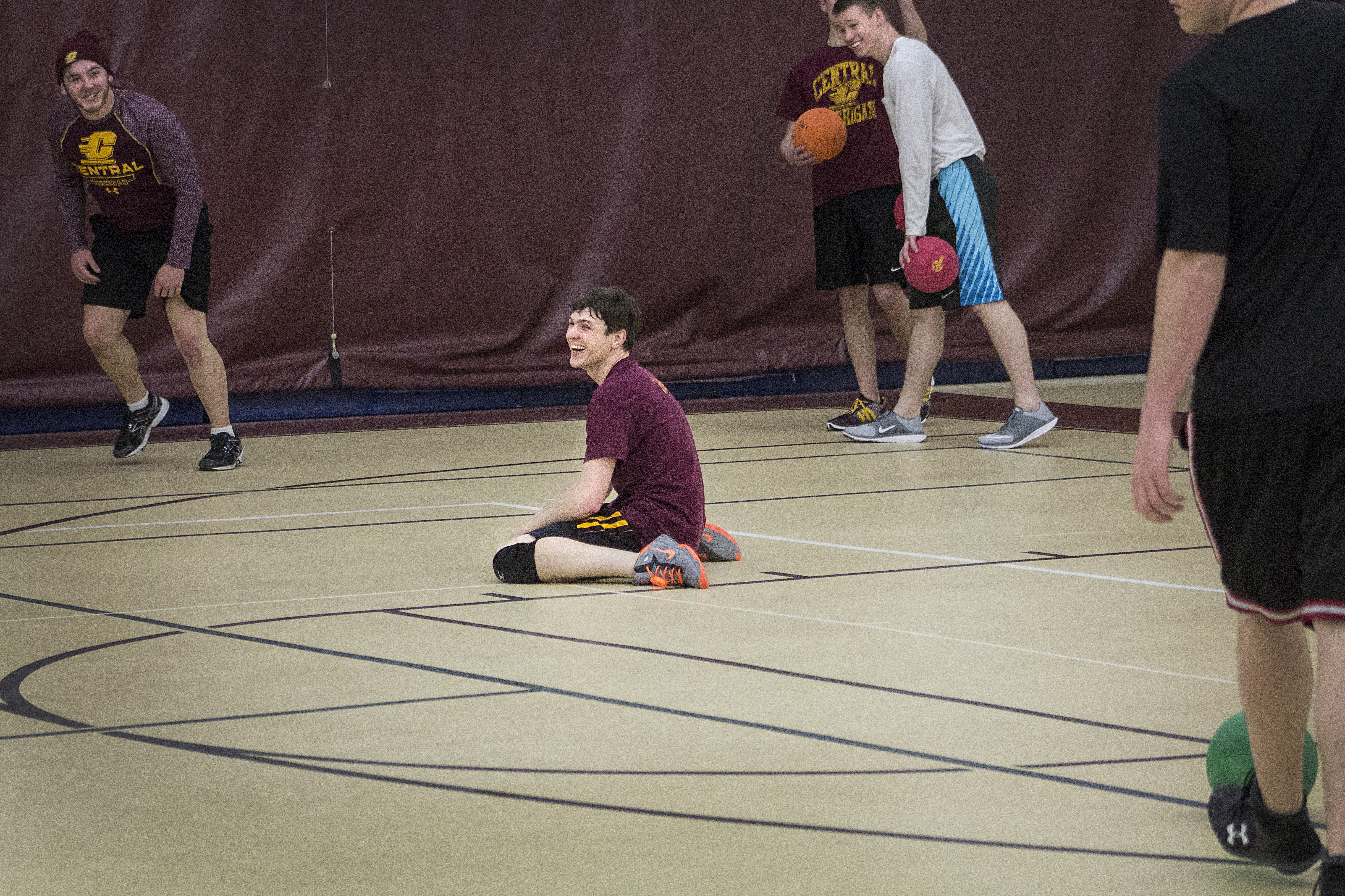
LaValley laughs amid his teammates as he falls to his knees after receiving a hit to the chest, which he fumbled to catch, making him out. “He spends a lot of time either in the air [making catches] or on the floor,” joked teammate and friend Merissa McTaggart.
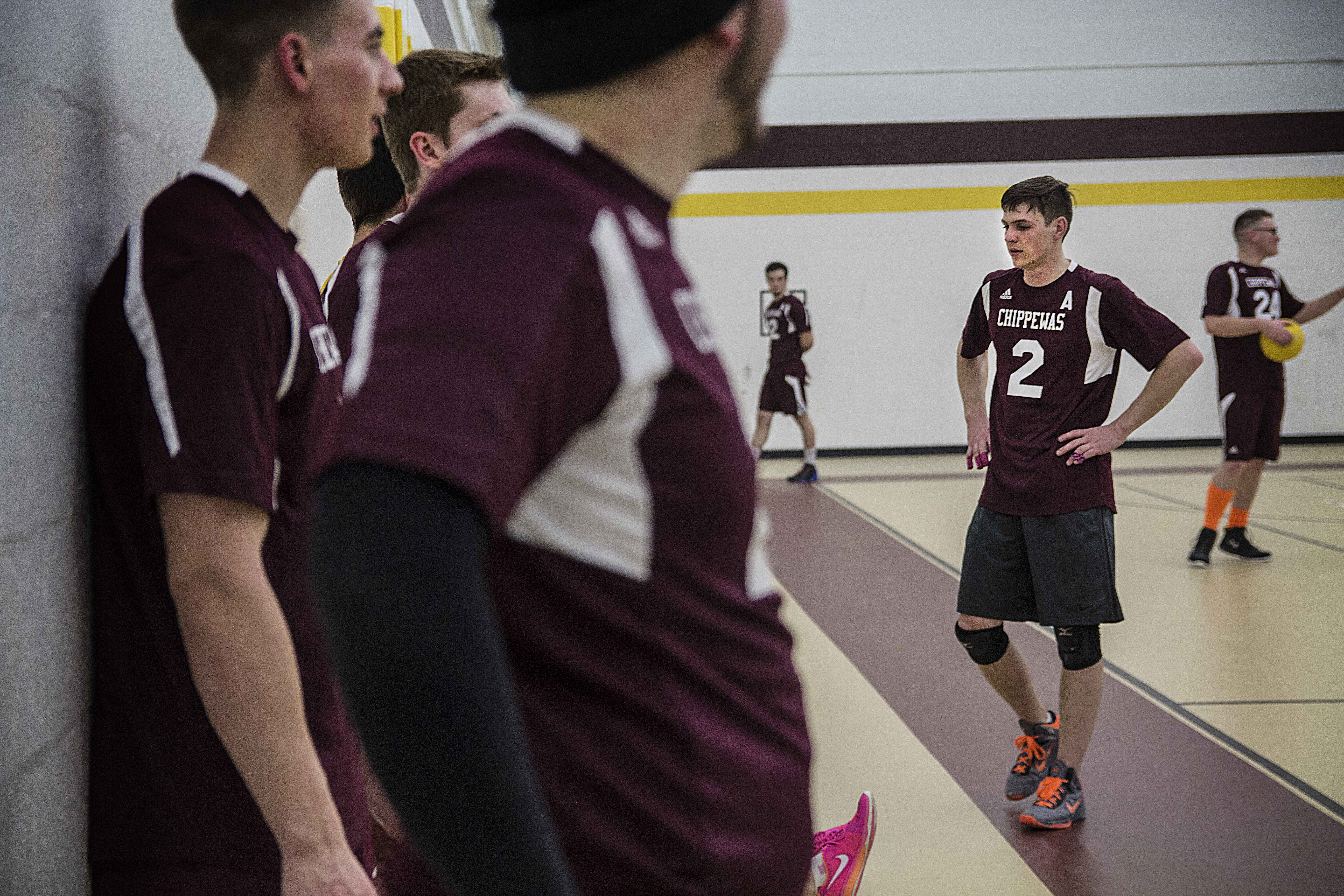
LaValley exits the court after being hit, disappointment visible on his face. The club status of this dodgeball team makes no difference in the dedication of its team members, and LaValley is no exception, taking losses especially hard when he feels he did not perform his best and do everything he could for his team.

Dodgeballs, when thrown in professional leagues can hit speeds of about 80mph… not something you want to get hit with at all, much less in the face. Usually, the team plays strategically. “If we can take out half their game in just catches,” said LaValley, “we can really modify their game.” But no one can deny the feeling of hearing a ball make contact with an opposing player’s face. “Everyone cheers,” LaValley laughed, “It just amps everyone up.”

Scott LaValley schedules classes for the following semester, during study time with friend Merissa McTaggart at the Down Under Food Court. With dodgeball practices three times a week, in addition to responsibilities as the Team President and scheduling tournaments, LaValley is looking at another busy schedule next semester, but has no complaints.

In a long exposure shot, LaValley runs to the center line where he grabs his pall, winds up, and throws. Neon orange accents on his shoes leave trails. This illustration is meant to depict the stop-and-go feeling of both watching and playing dodgeball: While there are short bursts of intense action with multiple players, as each game gets closer to the end, the members on the court get fewer and farther between, and it is all about waiting for the perfect moment to fire.
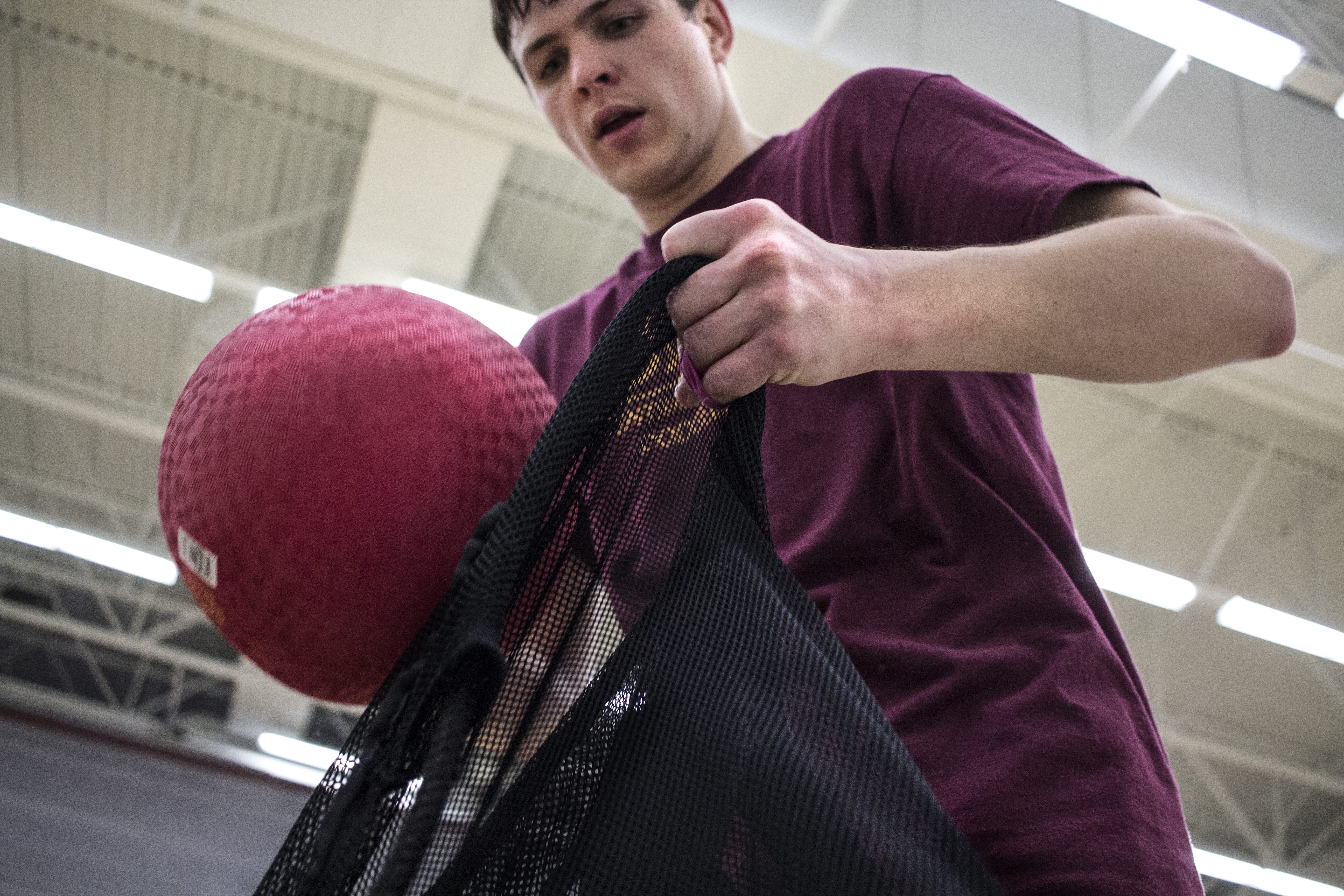
LaValley packs up loose balls after practice. The club dodgeball team uses a gymnasium in Rose Hall for their tri-weekly practices. However, relying on the university for practice space can lead to difficulties, especially during winter, with snow days and bad weather sometimes leading to cancelled practices.

Scott LaValley heads home after a two hour dodgeball practice, Thursday, March 24.
JRN521: Personal Vision Video
I had some exporting issues, so this is a terrible quality version. I just didn’t want to come to class without anything to show. I will update with a properly exported, full HD version as soon as possible.
JRN521: Your Choice Project #2 Profile Video
Personal Profile video:
Alexandria Rykse, Fashion Photographer
coming next…
Scott LeValley: Club Dodgeball

Final Project: Planning & Progress
This is a progress post for the planning on my final, capstone project.
Working title: Beyond the Binary.
I have narrowed down the specific topic I want to discuss, connecting the lives of the individual subjects featured. As I have begun to learn more about the personal stories of these subjects, as well as learn more about the LGBTQ+ community, I have realized that orientation/sexuality/attraction is less relevant to the topic I am interested in discussing. Not that this is not a huge part of any individual’s life, as it certainly is. However, the binary understanding with which we tend to approach the idea of attraction, to a non-binary individual, is effectively useless. When not everyone can fit within this binary frame of thinking, it is time for a shift. Who someone finds themselves attracted to is not who they are, and we need to move away from defining by those standards.
The main focus will be disambiguation between the terms ‘sex’ and ‘gender,’ as well as education on language. I will cover this in two parts: Firstly, sex. Specifically assigned sex, which is often misleadingly referred to as ‘biological’ sex, giving a falsely medical view to the term, which is, in our culture, essentially a glorified guess by the Doctor based on what the exterior genitals of an infant, “looks most like.” What is often viewed as so black and white is actually quite non-binary in and of itself.
Secondly, gender. Gender is one’s sense of self “in relation to the social constructs of masculinity, femininity and androgyny.” [1] When most individuals hear the term, ‘gender,’ the definition that comes to mind is more closely aligned with what are actually referred to as ‘gender roles:’ the culturally imposed ideas and associations that are paired with one’s sex.
I will focus on three subjects. I want to emphasize, that despite the apparent “similarities” that can be found between their labels, they have very different stories.
Multimedia Presentation
The main presentation of this story will be the video and copy including still images.
I intend to create a photo illustration based on an existing helpful resource: The Genderbread Person. I want to use this style of representation to allow each individual to “plot” themselves onto the chart, creating a visual explanation that can, ideally, be an approachable way to understand the important concepts, even while still in the process of learning the appropriate language. This illustration should give a basic idea what the project will be about, and as it will include the same individuals interviewed in the video, should give an idea of their story, even if someone does not watch the accompanying film. This portion will also include some examples throughout the spectrum, based on individuals who respond to the survey I have created.
This survey will be circulated throughout as many CMU classes as possible, as well as circulated by Transcend CMU, and, pending approval, the Offices of LQBTQ services.
JRN521: Your Choice Project #1
Editorial Illustrations:
“No One’s Body Should Put Them In Debt”

Gender Reassignment Procedures Linked to Improved Mental Health in Transgendered Individuals- As “non-traditional” gender identities become more commonly recognized, one could argue that transgender individuals have a better opportunity in the United States today than they have ever had. However, procedures and treatments that aid in the physical transition, including testosterone injections, breast reduction or removal surgery, and genital reassignment surgery, are still considered to be “elective” procedures, even when recommended by a therapist or psychiatrist, and as such, are not covered by many insurance providers. According to surveys, approximately 41 percent of trans or gender non-conforming people will attempt suicide, nearly ten times the likelihood of the average American (4.6 percent).
#FLINTMI



Flint Water Crisis Gains Public Headlines-Still no Solutions. What has come to be known as the Flint Water Crisis began in 2014-when Flint, Mich. switched away from Detroit city water- and continued, largely outside of the public’s eye, until it’s climax in late 2015/early 2016, gaining widespread attention, even that of presidential candidates. Still, the city of Flint continues to send bills for the toxic and un-useable water, and despite the thousands of bottles of donated water pouring in from around the country, its residents have no clear answers for how this problem will be solved.
[I included several alternate versions of the text, as I couldn’t decide which looked best.]
Portraits




Calli Kujat, a junior anthropology major from East Jordan, Michigan, holds a smoking match as she lights a cone of incense. A tapestry from India hangs on the wall behind her. “I want to travel…” Kujat said of the degree she is pursuing at Central Michigan University. “I think that I’d like to go into advocacy work… All I really know is that I want to help people.” Kujat transferred from Michigan State University, and hopes to continue her education here at CMU.



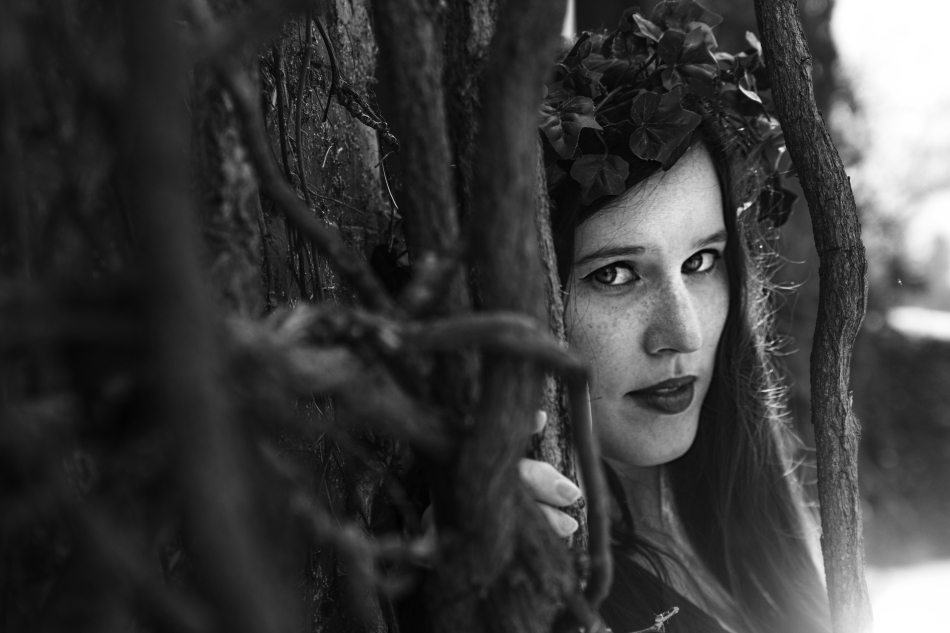
Port Huron senior Biology major and aspiring model, Merissa McTaggart, leans back into the vines that cover Smith Hall on CMU’s campus. The headpiece she wears is reminiscent of the spring, when the vines come to life, leaving the side of the building lush and green.
Jenn Ackerman: Presentation
This past week I had the awesome opportunity to chat on the phone with Jenn Ackerman, a Minneappolis photojournalist and filmmaker.
Perhaps best known for her work Trapped, Ackerman studied photography at the Danish School of Journalism.
Trapped takes us inside the Correctional Psychiatric Treatment Unit of the Kentucky State Reformatory to see how a state is meeting the needs of this growing population.
But as Ackerman’s career has evolved, she has begun to incorporate stunning portraiture into her stories, resulting in a cinematic peek into some fascinating characters and moments in time.
To check out my presentation, visit my Presi here.
Thanks for looking!
Baylen Brown
989.317.6665
baylenbrown.format.com
Online portfolio link
My online portfolio can be found here, for anyone interested. Thanks for a wonderful semester, everyone!
50/50: Living with Huntington’s
Candy Courser Newman hands her son Warren Ubele, 35, his Reliv shake, which detoxes the body and contains dietary supplements that help him to deal with the symptoms of Huntington’s disease (HD). Warren’s father, Mark, died from Huntington’s on May 20, 2011. “I don’t know if Mark knew Warren would have it-before he passed,” Candy said. “We knew he had it, but we didn’t know as much about it before we had kids; he sent away for tests, there was no internet then.”
“We started Reliv with Mark in September of 2008,” Candy said. “Mark was in a wheelchair because his balance was terrible… Within four days, he started talking again. Within two weeks he started feeding himself again, and within two months we didn’t need to use his wheelchair anymore because his balance had improved so much.”
Candy gets Warren’s medicine set out for the day, putting it into a cup so Warren can take it himself. “He does things so fast, he drops or knocks things over a lot.” said Candy.
Warren smokes a bowl of his medical marijuana in his bedroom. “He used to wash his hands and dry them, over and over and over,” Candy said. “The medical marijuana took that away.” Warren’s compulsive leg movement in years before medical marijuana was so severe he would wear holes into his mattress during his sleep.
Candy writes a check for her mother, Elaine Courser, 92, who lives in an apartment attached to Candy’s Mount Pleasant home. Candy’s mother used to love to paint, and the home is filled with her work, but because of her eyesight she is no longer able to do things, like paint, that require such fine attention to detail.
Candy vacuums the floor in front of Warren’s chair. “He always sits right here, all day, every day, and he makes a mess, but that’s why we have a vacuum,” Candy said. “For a while he was eatiing those sunflower seeds all the time and THAT was bad,”
Candy grinds up marijuana for Warren so he can smoke it more easily. “He used to cut it up with scissors but he was always hurting himself, and then I found out they have little grinders just for it,” Candy said. Because Warren’s insurance does not cover the use of medical marijuana, Candy must pay out of pocket, an expense that can add up to nearly $600 every month.
Warren takes the lid and straw out of his cup so Candy can refill it with Coke. “He still drinks five or six bottles of coke a day; I got him down from 10 to 12 cans, though. His HD specialist says the coke is OCD for him. (exhibiting signs of obsessive behavior is common in Huntington’s disease) He also tells me he loves me, over and over and over and over… One time I snapped at him and said ‘I KNOW Warren, you have to stop,’ and I felt bad right away, but he didn’t seem hurt. He said he was sorry, and maybe fifteen minutes of silence later, ‘I love you, Mom.’ So I just say ‘I love you too'”
A bucket of half-smoked cigarettes sits next to Warren’s chair on the porch connected to the ramp on the front of the house, which Candy’s nephew built so that they would have easy access in and out. Warren goes out to smoke a cigarette every few minutes, sometimes only taking a puff or two before returning inside. “It becomes about the routine, and the same thing every day,” Candy said. “It is the familiarity of things…. HD patients really need that.”
Candy paints her nails at the kitchen table on Saturday morning, December 6. “I used to paint the nails of the lady I took care of,” Candy said, “She couldn’t do it herself so it was like getting pampered, and we always did bright, sparkly colors, so I have lots of those. But I usually just like a simple red.”
Warren looks off the side of the porch towards the road as he smokes his cigarette. “I hate to say, but maybe one day when he falls and hits his head, and on one is there… maybe he won’t have to live through all those years with Huntingtons,” Candy said. “Everyone who has HD either dies from the disease or from complications like pneumonia or heart failure. There is no cure or treatment, and if you have Huntington’s, there is a 50/50 chance your kids will too.”
“I remember when Mark, first showed signs… he came home from deer hunting, which he did every November up north, and laid down in bed. I remember him asking me, ‘how do you close your eyes?’ So I just tried to explain how… I will always remember that moment.”
Warren was officially diagnosed with Huntington’s in 2010. His brother, Derrick, 22 also took the test earlier that year and tested ‘not likely’ to exhibit signs of the disease. Warren started taking Reliv in September of this year.
“I know what is coming for Warren,” said Candy, “but we just have to go through different kinds of things before he gets that far into the terrible disease.”
In July of 2013 Candy was working for McBride Quality Care Services, an agency that provides residential, educational, therapeutic, and recreational services for children and adults with developmental disabilities. Warren was living on his own, sleeping a lot and irregularly, often for 24-hours at a time.
“He was losing weight, never eating…” said Candy. “We talked… decided when the time came, he would come live with us, in the family home.”
Candy quit her job to take care of Warren full time. Though at this stage in his life, it is less that he needs ‘care’ and more that it is important for someone to be there in case of an accident. “In the morning when he gets up, he falls a lot because the medical marijuana has worn off,” Candy said. “But by even hours after he starts smoking it again, he gets better and better as the day goes on.
“I’m trying to find something to pay the bills, I’ve tried Mary Kay, AVON… Maybe if I could just focus on one thing,” Candy laughed, “But I just can’t, really.”
“Reliv helped him for a very long time. But the disease eventually took over again. My mom asked me if I thought the Reliv was keeping him alive, and I did think that it was. Then she asked me if I thought Mark would want that. I said no, if he understood, he probably wouldn’t. At that point, he was getting so I really couldn’t care for him by myself. I had to have someone here just about all day long which he really couldn’t afford. So I decided I would do what I had always said I wouldn’t do, put him in a nursing home. But I had to.”
Mark was diagnosed with HD at age 36. Warren started showing signs at 21. Because Warren is dealing with HD earlier in life, he is not likely to live as long as his father.
“If I could do it all over again,” Candy said, “I would put my kids first, and I would have stayed with Mark because I cared for him anyway…”
420:Final Portrait
CMU Junior Amanda Viges poses in the studio for a portrait after her performance with the Central Michigan University Choir on December 6, 2014.
422: Bounce Flash
Last night in class we did an exercise with bounce flash. I wasn’t excited. It’s the week before finals, it’s freezing-ass-cold outside, I have so many things to do, and I’m already taking a lighting class. Why do I need this. I don’t have time for this. That was all I could think.
Until we actually started shooting, that is. Which was when I immediately realized that I am an idiot for thinking that Kent would waste time teaching us anything that wasn’t worth knowing. I have loved JRN420 and learning about lighting, but it’s been quite a hassle. The photos turn out beautifully, but so much work goes into the setup.
The thing I have loved about 422 is that it’s just straight documentation; no posing people, no formal interviews, just the simple and pretty enjoyable task of getting to know people, getting into a space, and shooting as many precious moments as your heart desires.
Bounce flash is the best of both worlds; you don’t have to have anything but a camera, something to bounce off, and a strobe. That means, wherever the hell you are, whatever you are doing, you can have gorgeous light. Just like that. Without any pain in the ass, without having to carry light stands around, without having to worry about what happens when the space is too cramped for a light setup.
I can’t believe that it’s that easy. I can’t wait to get my own strobe and play with it some more. Before now I had this idea in mind that if I was going to invest the money into buying lighting equipment, I might as well go all out and buy several lights, stands, wizards, everything, or it really wasn’t worth it.
It’s pretty cool to come to the realization that just having one flash and actually knowing how to use it could make everything I do that much better.
So cool.
This first shot is pretty blown out, but I was really impressed with how well bouncing off the wall about 50 feet off the ground and away from Alexis created enough bounce flash to OVERexpose the photo.
This one could use a little brightening, but again, Alexis is about 25 feet from the wall I bounced off; this time the wall was a brown brick wall, not the white sleek walls of the ET building, which I think might have affected how the light was not quite as intense.
422: Caretaker Single
Candy Courser Newman stands in the living room as her son Warren, 34, sits watching TV in Candy’s Mount Pleasant home. Warren moved back into his childhood home to live with his mother last July, a year after he was diagnosed with Huntington’s Disease. “I took care of his dad until his death in May of 2011,” Candy says. “Warren acts nothing like his Dad did…But eventually every person with HD will lose the ability to do anything for themselves, they become bedridden.” Every individual who is diagnosed with Huntington’s Disease will eventually either succumb to the illness, or die from complications. There is no known cure or treatment for HD.
420: Editorial Illustration
“Medical Marijuana Uninsured: Burning Money”
I went into this with this idea in mind:
I have been taking photos of a mother and her son, Warren, 34, who has Huntington’s disease, the last few days. Huntington’s is a disease with no known cure or treatment, and everyone who suffers from Huntington’s will eventually die either from the disease itself or complications, including heart failure and pneumonia. In the two years since Warren has been diagnosed, he has gone from living in his own home to living with his mother, depending on her for nearly everything he does. Medical marijuana has been a heaven-send to them; it allows Warren to sleep at night, when in years past he would literally wear holes in the mattress from his compulsive leg movement. It also allows Warren to eat regularly, which is a struggle because Huntington’s often affects the area of the brain which tells you you are hungry, so those suffering with the disease often rapidly lose massive amounts of weight. Because Warren’s insurance does not cover the use of medical marijuana, his mother must pay out of pocket, an expense that, even with the discount their seller gives them, averages about $600 every month.
—
However: in the execution of my idea, I realized something. Firstly, my idea to combine a rolled up dollar bill and a cigarette worked fine, but the end result was pretty clear that it was a cigarette-which makes the idea look more like a statement about how smoking cigarettes is a waste of money (which I suppose is true, so I’m fine with that interpretation). I tried to draw some attention away from the cigarette itself by adding the burning dollar bill and cloning out the ‘camel’ logo on the cigarette, but I don’t know how much it helped.
420: portfolio single, fashion
The model displays a set of hammered gold bangle bracelets and midi rings, whose soft, organic warmth is complimented by the sharp, clean edges of the Citrine crystal. Citrine is thought to attract wealth and prosperity, calm fears and anxiety, and stimulate intuition or the “third eye”.
420: Photo Illustraion-In Class
With Black Friday sales starting earlier and earlier each year, employees of stores hosting these sales are forced to work more and more hours during the holidays. This places many of these minimum wage employees in a position where they must spend their holiday working so their family can afford to celebrate, often without them.
422: Poverty
Ryan Strye and girlfriend Kara Soper have been staying with their friend at his Mount Pleasant apartment for the last several months, since Kara lost her job. “We love to cook, especially for our friends, when we can afford to,” Strye said. “You can make those bridge bucks last, a good crock pot meal will feed us for a week”
Ryan Strye, 28, smokes a cigarette outside a friend’s apartment where he and his girlfriend Kara Soper are currently staying for free in Mount Pleasant, Mich. “Being impoverished is like this embarrassing thing to some people, like you failed, you’re a failure,” Strye said. “You just have to embrace what you have.”
420: Still Life
I had a lot of ideas for this assignment, but none of them seemed to turn out like I wanted. I personally really liked the examples from class that were very simple and striking, so I picked a few objects that I thought had nice textures, etc, and my original plan was to do some super macro-photos of some rocks/crystals and to use the lighting to make the transparent parts of the crystals look almost glowing. This ended up being very difficult, I don’t have a macro lens and the magnifying glass I tried using must not have been the best, because I noticed even at f16 I wasn’t able to keep as much of the frame in focus as I wanted. It might be an idea to revisit another time, though.
I decided to focus on the lighting rather than the object itself, first tried working with shadows a little bit, but since I was shooting at home and my backdrop wasn’t ideal, that wasn’t working too well either, so I went with my final idea.
I wanted the different colors in the smoke to be more apparent ( I used one blue gel and one light with no gel) and give it more dimension, but they ended up being very subtle. I’m very happy with them, though, compared to how the smoke during the shoot actually looked, the smoke here in the final image is much more pronounced and dimensional. I used a 5-6 second exposure, and flashed the smoke twice, from the back left (below the smoke) and from the back right (about level with it) to try to create more dimension. I wanted to try red smoke but I had problems seeing it as it blended in with my background more than the lighter colors. Overall I’m very happy with these, they aren’t maybe the most creative, but I think the execution worked well, and in the end they are what I wanted: (I hope) striking and simple.
By using multi-colored lights, two exposures of the smoke, three seconds apart are combined, in the makeshift studio at the artists home in Mount Pleasant, Sunday night, creating a fuller, subtly multi-dimensional effect.
(blue light was below and behind to the left of the smoke, white light was level with smoke, to the right, a little further back)
The lamp here was off during the actual shoot.

422: Counterculture
“After spending more than a decade throwing shows, running sound, releasing compilation CDs and just about anything else supporting the local Mid-Michigan Underground scene and the Christian scene, In the summer of 2000, Bryan Hampton decided to finally do what most people start out doing in the scene…Start a punk rock band.
Adam is Bryan’s 14 year old son (who was born just a couple weeks after Desiring Dead Flesh’s 1st show). Adam joined the band at 8 years old as the drummer. After playing about 200 shows on drums Adam switched to bass guitar in September 2013. So he could ‘move around’ more during the shows.
Ravyn is Bryan’s 11 year old daughter and joined Desiring Dead Flesh playing guitar in September 2013 (when she was 10). Ravyn also sings and writes the lyrics for her side project with Adam called “Harry and the Dingleberries”.”
-Desiring Dead Flesh’s facebook page
“Blood, Sweat and Circle Pits”:
Desiring Dead Flesh
Bryan Hampton leans in to share the microphone with son Adam for the gang vocal part in “A Day with Dad.” Bryan wrote the song about his son Adam, and about his relationship with his father, “At 17 months, its all exciting and new, you love what ever it is I do with you…”

Bryan closes his eyes in prayer in the family room at his home in Bay City, Michigan. The Hamptons host So Am I Bible Study at their home Monday nights at 7:00pm. “First Samuel, Eight, this is one of the best anti-government paragraphs in the bible,” Hampton explained to the group Monday night, October 18. “God gave ’em what they asked for. I think churches like the idea of a central figurehead, but we like much more the idea of a king…who will dictate for us and fight our battles.”
Adam, 14, practices bass with his dad at their home in Bay City in their soundproofed ‘music room.’ “Adam used to play drums,” said Bryan, “But he switched to bass so he could get up and move around.”
Adam and Ravyn, 14 and 11, help unload cables for the PA setup at their Pinconning show Thursday, October 29. Dad Bryan also runs Not My Show PA-Rentals, as well as Ripped Heart Productions, so even when the band is not playing, Bryan is usually working sound at shows.

Bryan Hampton holds out the tabs to ‘Unity Beyond,’ as his son Adam plays along on bass guitar at band practice . “1500 churches close every year…that doesn’t seem like (the way) it should be on a system that God set up,” Bryan said. “What’s the saying, ‘cord of three strands isn’t easily broken…’ We are all connected to each other, the more connections we have, the stronger we are”
Adam laughs with parents Julie and Bryan before Desiring Dead Flesh goes on at 7:00pm Thursday night. “I’m tired already, says Julie, dressed for Halloween in her bathrobe and curlers, carrying a rolling pin, “I don’t come out as much as I want to, as much as I used to, they usually go so late.”
Ravyn tunes her guitar before DDF starts their set on Thursday night. “They didn’t even do their hair up tonight,” says mom, Julie, “But we found these and I thought I’d make them superhero capes to wear.”
Ravyn, 11, and dad, Bryan, load the last of the gear into the van for their show Thursday night in Pinconning. “She usually falls asleep on the ride,” said Bryan. “But it works out, cause sometimes they are up until pretty late-Last tour we took a picture of her sleeping in the van every day of the tour.”
“I see you in the car seat, fearing the possibility
Your choices will lead us down different paths entirely.
Will you leave behind the life I share with you?
Maybe, but for now I’ll enjoy my time with you.”
-‘A Day With Dad’, Desiring Dead Flesh, 2001
420:Painting With Light
This has been the hardest (and most frustrating) assignment so far. Our group really struggled when we did our in-class photo, and I though the solution was to have a better plan of action. Apparently I was wrong. The solution to getting this assignment right seems to be more like this: have enough time and patience, and prepare to try 1000 times, and have enough knowledge to figure out what exactly the HELL is going wrong so you can try fix it. I struggled a lot with these photos, and it wasn’t all equipment issues, but that definitely didn’t help. One of my strobes didn’t work at all, and my the remote wasn’t wanting to work on my bulb setting so we kept accidentally setting off 30 second exposures and running out of time.
My first shoot I thought I had planned out really well, but I realized pretty quickly that I didn’t have enough space to light it like I had wanted to. I also discovered that I only had one working strobe to work with, so I rigged up the two colored gels I needed to a snoot I made. (I should get an A just for this beautiful creation)
I wanted the model sitting on the couch under the “imagine” poster, and I wanted to make it look like his head was inside a space helmet sort of thing, by using my globe. I also wanted to try to make it look like there were stars or maybe a little galaxy around his helmet. Anyway, after a few tries I realized my idea was clearly too complicated and wasn’t going to work, so I cut it down and decided to just focus on two colors and just make it as clean as I could. They didn’t turn out great, but I think they are at least interesting, and I think the idea is worth revisiting in the future, definitely in a different setting.

The next idea was I wanted to create a scene where a model sat in front of a great big old book in the middle of a 5-point star little circle made of candles, with ghostly hands lighting the candles around her. The plan was to 1)release the shutter, 2) “light” each candle by sparking a lighter in front of it to create a fake flame. 3)strobe model sitting in the center of the circle, and 4)remove the model and strobe just a hand lighting each candle with a red gel.

Obviously there were some things that worked and some that didn’t. I figured I could just spark a lighter to create the fake flame, not realizing that it was so bright that sparking it five times pretty much ruined my exposure, making the rest of the colored lights look really dim in comparison, and everything was over-exposed. So I decided to remove the model and just focus on getting the hands right, which I really had a hard time with.
First I strobed the whole scene with a snoot, to give it at least some sort of dimensional lighting instead of just flat light. I kind of like the angled spotlight sort of look, I think it works since the idea is sort of overdramatic anyway. Then I strobed the hand holding the candles down to “light” the circle, using a red gel for each one. It seemed simple but it took a LOT of tries before I finally got them all in the shot. I did some touching up in photoshop, there are a couple places where you could see a slight outline of my shoe (oops, even wore black shoes..) which I darkened, and I also removed a lot of bits of dirt and whatever on the black cloth, because it was really distracting to me. I’m not a huge fan, I’d like to go back and redo it sometime with a couple helpers, figure out a way to fake “flames” without ruining the exposure, but for just being me and Emily, I think it turned out pretty well.
420: Painting with Light-In Class
bulb exposure, probably about a minute long, first setup attempt at doing the “circus” theme. Some things worked-Sammy is pretty well lit, Shannon in green looks good, but there was just too much that could go wrong. The ladder needed to be blocked off somehow, and the idea to fill flash the entire scene was a terrible one-first off it way over exposed Kaelyn in the front left, second it created this weird illumnation of the ground, which was really uneven and just looked off, and thirdly it illuminated the ladder, which was meant to be hidden.
I think we could have done a better job if we had JUST stuck with lighting each character with a colored gel, but our group decided to give up on this positioning eventually and go for a simpler setup, where all the characters were basically on the same plane.
30 second exposure of our group posing as a circus freakshow, fronted by Sammy as the Ringmaster. The ambient light form the burning pumpkin ruined the sharp image the strobe created, so we didn’t end up using this setup, but I liked the way the colors ended up.
Shooting with the class definitely made it clear how you REALLY need to have a plan. Our plan was WAY too complicated, involved WAY too many models and lights, and we just didn’t have the time or equipment we needed. On top of that, our idea revolved around costumes, not an actual CONCEPT.
This influenced me to decide to use only single models in each of my painting with light photos, to keep things simple so I can do the best job I can do. I also learned that it’s going to take a while, which I think was good, because otherwise I would have went out to shoot and felt like it was taking too long, going terribly, etc. Now I know it’s all about trial and error and figuring out what works and what doesn’t.
I’m excited to try my own concepts.
Baylen
Thought Piece III
October 22, 2014
LaBelle starts off in this bit of reading talking about feature hunting, and knowing what makes a good feature. One thing he said that stuck with me is that even though some people have a natural eye for what makes a good feature, it Is still a skill that can be taught.
I think the reason this stuck with me is because photography has always come naturally to me; I like to think I have a natural ability, I can tell a good photo when I see it, I’m always noticing little details other might miss, and I can usually make a good photo even with not-so-good photo equipment. What this chapter made me think about is how to sort of harness that ability and learn how to use it to my advantage. Sometimes I think that ability creates sort of an over-confidence. It’s not that I think that I can do no wrong-I take plenty of shitty photos. However, sometimes I end up looking at it with the attitude that, because I have an eye for what looks good, I can just go out and get good photos no matter what, and that if I DON’T find a good feature, there must not have been one to find.
I think this general attitude is a problem for me, finding a balance between confidence in my natural ability and fighting the “I can’t do this” feeling. Confidence has always been a struggle for me, so now that I have reached a place where I AM confident in my work, I need to focus on making sure I keep determined and don’t get lazy.
The list of ideas for what can make a good feature were really helpful-some of them are things I already look for in a photo, but some of them are things I would never think of. Firstly, the list isn’t just a list of “cool shit to take photos of,” it’s more than that; the list of things makes you WORK to find photos-climb up high, get down low, find interesting angles, look for action and emotion, etc. I think LaBelle is doing two things with this list-firstly, he is drawing you a map, telling you where and how to look for good features that are outside the box. But more importantly, he is stressing that if you do these things, and if you learn to look for these things, the end goal won’t be one surprise feature-it will be a new outlook, and an entirely new approach to feature-hunting.
The next part features some ideas for methods of finding features. These are a little more specific ideas for where you can start if you don’t have much (or anything) to go on. Some of these ideas are ones I have used without even realizing it; Brainstorming and “cruising” in particular.
I always like reading LaBelle’s writing because he doesn’t just give you a “this is how I do what I do,” explaination. Instead he gives you a “this is how YOU can do what I do.” There’s a huge difference-not everyone’s methods are the same, one person’s secret might not work for another-but LaBelle has broken it down into ideas that will work for ANYONE, because they aren’t about a specific story or photo, they are about how YOU look at the world, and in turn, how you will portray the world with your photos.
420: Fashion
Emily Brouwer, CMU Senior, poses in a faux fur jacket against the back of a warehouse building on Mission Road Thursday, October 9, in Mount Pleasant, Mich.
(setup: backlight about a foot behind emily, about waist-level pointed up, light to the left about 20 feet away. There was a yellowish light on the building about 10 feet down and 20 feet above where we were shooting, which didn’t affect the color of the pictures like i thought it would, the flash had no problem overpowering it. it did make it helpful in giving me some light for focusing on her face, though)
In the Studio:
Emily Brouwer models a plum red lipstick, looking over her shoulder into the light in the studio in Wightman Hall on CMU’s campus this thursday, October 9.
(setup: emily sat on the stool, we rigged up a way to hold the lace in place without an assistant, i stood on the step stool and shot down. we varied up this setup the whole time, keeping the lace close to emily and the light farther back seemed to be the best way to make crisp shadows, but i think that my choice to bring white lace was kind of stupid, i’m sure black lace would have done a much better job, the white just let too much light pass through it.)












